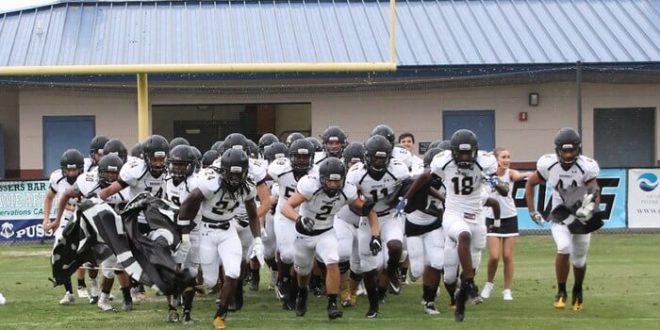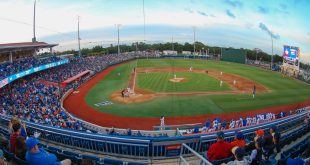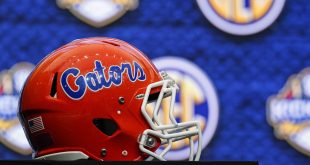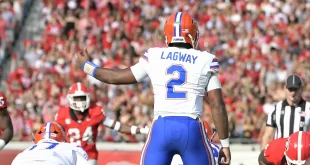You’ve heard about the schedule changes COVID-19 caused in the NFL this year. You maybe even got frustrated when your favorite college football team had games entirely canceled. The pandemic has certainly affected the college and professional leagues, but high school football has not been immune, either. In fact, it is probably the level that has suffered the most because of the pandemic.
A summer of uncertainty in Florida led some teams to opt-out entirely after the Florida High School Athletic Association decided to plow forward with a season. In the fall, games have been canceled because of positive tests around Alachua County. As cancellations piled up, including at Gainesville High School, the number of games teams could play varied.
Gainesville ended up playing five regular-season games. Buchholz, Gainesville’s intracity rival, played seven before its playoff run.
“We had seen we had several programs that decided to have senior night on that first or second week of the season, just not knowing when this thing would end,” said Graham Hall, a sports reporter for the Gainesville Sun.
The biggest barrier between high school football and its collegiate and professional counterparts is resources.
In a normal year, that usually means facilities. In 2020, it’s all about access to COVID-19 tests and the ability to isolate a team and keep players healthy enough to field a team. Without enough healthy players, games are canceled and all players from two teams lose an opportunity to prove to college coaches that they’re ready to make the leap evaporate.
Hall doesn’t think a season marred by COVID-19 will have a big effect on seniors. Rather, sophomores and juniors are going to hurt from not having that tape. Most seniors already have committed or been recruited by programs heading into their final fall, Hall said. So, missing a game or two this season likely won’t make or break their career.
Out at Hawthorne-Madison County for state semifinals and it’s as packed as it’s been all season. Kickoff in 10 minutes. pic.twitter.com/zUBDDumBzK
— Graham Hall (@GrahamHall) December 5, 2020
The games matter, of course, but seven-on-seven football, which is played without pads or tackling, is where many student athletes get noticed. Hall identified the months from December through March as the “notice period” for many prospective college football players. If things are not back to normal by 2021, a whole new crop of players will be affected.
“Getting noticed as a prospect as a sophomore or freshman is going to become much harder without that period,” Hall said.
There is a bit of a silver lining in the confusion and stress of 2020 for high school football players looking to get recruited, Hall said.
“It’s much easier for prospects to compile their film and share it and possibly get it noticed than it would be if this pandemic hit like 20 years ago,” he said. “So that’s certainly a factor worth noting, communication is also easier.”
Jerome Reed works to make that communication even easier. Reed is the president and co-founder of R.A.W.E. Recruits, which stands for Reaching Athletes with Education. His organization focuses on helping high school athletes in North Central Florida get recruited. That includes helping players assemble video highlights and aiding in contact with coaches.
Reed said since summer football camps were shut down because of COVID-19, more people in the football world have reached out to him for assistance with evaluations and getting film for specific athletes.
https://twitter.com/RAWE_RECRUITS/status/1335705234425974788?s=20
Another wrinkle to the college football structure that affects high school players was the NCAA offering up an additional year of eligibility for athletes enrolled for the 2020-2021 academic year. This may result in upperclassmen coming back to improve their draft stock. That could also bar incoming freshmen from seeing opportunities with a backlogged depth chart.
“The consensus feeling is that it is extremely difficult to place some of these kids who really have our great talents, great students, but because of that extra year situation is very tough and they’re trying their best to fight through it,” Reed said. “But you can imagine how easy it is to get discouraged in a time like this.”
Reed said players he’s talked to have been relying on their tape from 2019 to entice college coaches.
“It’s not like the college coaches or college scouts don’t recognize the situation that you understand that a lot of these high school programs have to rely on that 2019 season or half of the 2020 season,” he said.
There have been some issues in traveling to cover games during a pandemic, Reed said. It’s easier to remain local, where connections have already been made with coaches and athletic directors at area high schools. But as Reed said, it’s not all the same.
When he’s traveling “the mask stays in the backpack.”
Hall said his job hasn’t changed significantly. He’s still been on the sidelines this fall, albeit, masked. Reporting on which teams will actually be playing on Friday nights and which succumbed to COVID-19 outbreaks is now just as much a job as writing up who dazzled under the Friday night lights.
At times, Hall has worried when a team he covered had a player test positive. Still, he believes the focus should be on the players whose careers have been hindered by the pandemic, even if his own safety is his personal priority.
“I’m someone with asthma and so early on in the pandemic, I was a little bit fearful in a sense. Like, ‘Oh man this is, this is not good,’” Hall said. “So I’m thinking of that every single time [I cover a game].”
Mike Farrell’s job as the national recruiting director for Rivals.com hasn’t changed, either. It’s just become harder. He said evaluations of players have become increasingly difficult since shutdowns in March. There’s an increased reliance on older tape and traveling out to watch certain prospects is hampered by safety concerns.
“From our perspective, I think the rankings are going to be the one area that really suffers,” he said.
Rivals.com, 247Sports and ESPN are the major sites that rank the high school football recruits in the country. The accuracy of those rankings may take a hit this recruiting cycle for the class of 2021.
Very heady stuff here for new 5 star @Jacoby2Mathews as we all know how much I liked @DerwinJames out of HS. pic.twitter.com/EkGXOT6AYs
— Mike Farrell (@mfarrellsports) December 7, 2020
Farrell expects the NCAA to extend the scholarship limit for a few years. This would address any potential issues with the extra year of eligibility granted with new freshmen coming in every year.
One of the main issues he brought up was the lack of connection between players and programs with visits to campuses out the window for this year. Virtual tours do something to address the issue, Farrell noted. But it isn’t the same as stepping on campus and touring facilities.
He added that it will be difficult for players to connect with coaches before arriving on campus because visits are limited both ways. And because of that, he expects some players may show up to schools in the summer or fall without a great prior relationship with a position coach or otherwise.
The unknowns of 2020 will have lasting effects on college football because of the current impact on high school football. The vast unknowns are to blame for those ballooning concerns.
“There’s the legacy this class is going to be looking back, you know, three, four years from now, and seeing a lot of misses,” Farrell said. “More than normal. You’re going to see in the first round, a lot of three-star, two-star kids.”
 ESPN 98.1 FM / 850 AM WRUF ESPN 98.1 FM / 850 AM WRUF
ESPN 98.1 FM / 850 AM WRUF ESPN 98.1 FM / 850 AM WRUF



